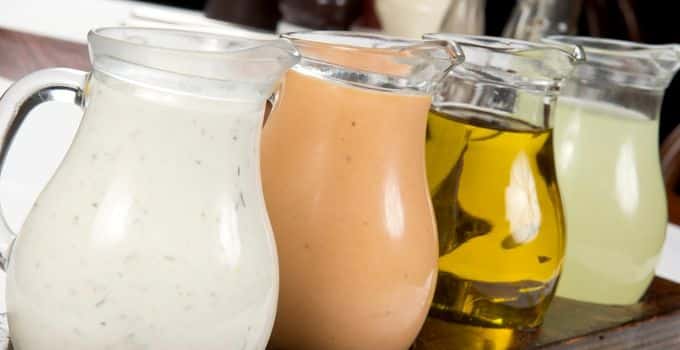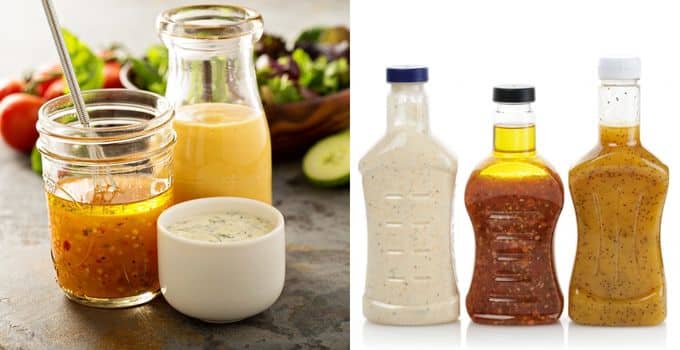Salad dressings will provide numerous benefits and keep you healthy if you choose the right combination.
However, not understanding the implications each type of salad dressing has on your body may negatively impact your health, especially if you suffer from acid reflux.
The following article will cover everything you need to know to choose the best salad dressings for acid reflux.
Types of Salad Dressings

Let’s start by comparing several ways salad dressings can be categorized.
The most common way is to categorize them by their base ingredient, such as oil-based, cream-based, or vinegar-based dressings.
Another way is to categorize them by their flavor profile, such as tangy, sweet, or savory dressings.
In other cases, marinades, dips, or salad dressings can also be categorized based on their intended use.
Finally, dressings can be categorized by consistency, such as thick and creamy or thin and runny.
Since this article focuses on Gerd symptoms, the most crucial factor is the base ingredient. We will focus on these categories to exemplify the best and worst salad dressings for Gerd.
Salad dressings by base Ingredients
1. Oil-based Dressings
Oil-based salad dressings are a popular choice for their rich and creamy texture. They are typically made from a blend of oils, such as olive, avocado, sesame, or walnut, mixed with other ingredients, such as lemon juice, vinegar, herbs, and spices.
While oil-based dressings can add flavor and texture to your salad, they can also trigger GERD symptoms in some individuals. The high-fat content in oil-based dressings can slow the digestive process and cause the stomach to produce more acid, leading to heartburn and other acid reflux symptoms.
However, not all oil-based dressings are created equal.
Opting for lighter oils, such as avocado or walnut oil, and balancing them with acidic ingredients like lemon juice, can help reduce the risk of acid reflux. Additionally, using oil-based dressings in moderation can help reduce the risk of triggering symptoms.
Most popular oil-based dressings include:
- Olive oil and lemon dressing
- Avocado oil dressing
- Sesame oil and ginger dressing
- Walnut oil dressing
2. Cream-based Dressings
Cream-based salad dressings use dairy products, such as cream, sour cream, or buttermilk, as a base ingredient. These dressings tend to have a thicker, creamier texture compared to other types of dressings. They are commonly used in salads that feature fruits, nuts, or cheese.
This base type is probably the most popular, but at the same time, the ones that may negatively impact your health when combined with acid reflux.
Most popular cream-based dressings include:
- Ranch Dressing
- Caesar Dressing
- Blue Cheese Dressing
- Thousand Island Dressing
3. Vinegar-based Dressings
Vinegar-based dressings are dressings that use vinegar as a primary ingredient.
These dressings are a healthier alternative to creamy dressings because they are typically lower in calories and fat and provide a tangy flavor that can enhance the taste of salads.
One benefit of vinegar-based dressings is that they are high in acetic acid, which can benefit health. Acetic acid has been shown to improve digestion, lower blood sugar levels, and reduce inflammation. Some research has also suggested that vinegar-based dressings may help with weight loss by increasing feelings of fullness and reducing calorie intake.
Some examples of vinegar used in salad dressings are:
- Apple cider vinegar
- Balsamic vinegar
- Red wine vinegar
4. Yogurt-based Dressings
Yogurt contains probiotics, which are live bacteria that can improve gut health and boost the immune system.
These probiotics can also aid digestion and reduce inflammation in the gut, making it a healthier alternative to traditional creamy dressings because they are lower in fat and calories while still providing a creamy texture.
In addition to the health benefits of yogurt, yogurt-based dressings can also be a good source of protein, calcium, and other essential nutrients. Adding herbs, spices, or other flavorings can be easily customized to suit individual tastes.
Some examples of yogurt-based dressings include tzatziki, which is made with Greek yogurt, cucumber, garlic, and dill, and raita, which is made with yogurt, cucumber, and spices. These dressings can be used to add flavor and nutrition to salads, as well as a dip for vegetables and other snacks.
Related Article: Best Alcohol For Acid Reflux
Top 5 Best Salad Dressings For People With Acid Reflux

1. Apple cider Vinaigrette
This is the best option we recommend, not only as a salad dressing option but as a general healthy superfood option to improve gut health.
Adding a tablespoon of apple cider vinegar before your meals will have an amazing impact on your health, improving digestion and reducing heartburn symptoms.
Having said that, here are a few recipes to consider.
- Basic Apple Cider Vinaigrette:
- 1/4 cup apple cider vinegar
- 1/4 cup extra-virgin olive oil
- 1 tablespoon honey
- 1 teaspoon Dijon mustard
- Salt and black pepper to taste
2. Sweet and Tangy Apple Cider Vinaigrette:
- 1/4 cup apple cider vinegar
- 1/4 cup extra-virgin olive oil
- 1 tablespoon honey
- 1 tablespoon dijon mustard
- 1 tablespoon chopped shallot
- 1/4 teaspoon salt
- 1/4 teaspoon black pepper
2. Olive oil and lemon dressing
Olive oil and lemon dressing can be a good choice because it is low in fat and acidity. Olive oil is a healthy fat that contains monounsaturated fatty acids and antioxidants and has been shown to reduce inflammation in the body.
Lemon juice, on the other hand, is a fruit juice that provides a bright, citrusy flavor balancing the ph level in the stomach to avoid triggering acid reflux symptoms.
When combined as a salad dressing, olive oil and lemon juice create a flavorful and healthy option. In addition, this dressing is easy to make at home with simple ingredients and can be customized with herbs, spices, or other flavorings to suit individual tastes.
3. Tahini dressings
Tahini dressing is a creamy, savory dressing made from tahini, a paste made from ground sesame seeds. It is a popular dressing in Middle Eastern cuisine and is often used to dress salads, drizzle over roasted vegetables, or dip. Tahini dressing is a good option for those with acid reflux as it is typically low in fat and can be made with ingredients that are less likely to trigger reflux.
To prepare tahini dressing, you will need the following ingredients:
- 1/2 cup tahini
- 1/4 cup water
- 1/4 cup lemon juice
- 1 clove garlic, minced
- 1/4 teaspoon salt
- 1/4 teaspoon cumin
- Optional: honey, to taste
To make the dressing, whisk together all of the ingredients in a bowl until smooth and creamy. If the dressing is too thick, add more water, a tablespoon at a time, until it reaches your desired consistency. Taste and adjust the seasoning as needed, adding more salt or cumin if desired. If you prefer a slightly sweeter dressing, you can add a small amount of honey to taste.
4. Greek Yogurt Ranch Dressing
Greek yogurt ranch dressing is a healthier version of the classic ranch dressing. It uses Greek yogurt instead of mayonnaise and sour cream to create a creamy texture. Greek yogurt is higher in protein and lower in fat than traditional ranch dressing ingredients, making it a good option for those who are health-conscious or have acid reflux.
To prepare Greek yogurt ranch dressing, you will need the following ingredients:
- 1 cup plain Greek yogurt
- 1/4 cup milk
- 1 tablespoon chopped fresh dill
- 1 tablespoon chopped fresh chives
- 1 tablespoon chopped fresh parsley
- 1 clove garlic, minced
- 1 teaspoon onion powder
- 1/2 teaspoon salt
- 1/4 teaspoon black pepper
Related Article: How To Eat Pizza With Acid Reflux
What Salad Dressings Should You Avoid If You Suffer From Gerd?

These dressings should be avoided because they are high in fat and can slow down digestion, producing excess stomach acid and triggering acid reflux symptoms. Some dressings contain ingredients that can irritate the stomach, further exacerbating the symptoms.
- Ranch dressing: Ranch dressing is high in fat and contains a lot of mayonnaise, which can slow down digestion and increase the production of stomach acid.
- Caesar dressing: Caesar dressing is high in fat and contains anchovies, which can increase the risk of heartburn. The high salt levels in Caesar dressing can also contribute to symptoms of acid reflux.
- Blue cheese dressing: Blue cheese dressing is high in fat and contains mold-ripened cheese, which can increase the risk of heartburn. Additionally, the strong flavor of blue cheese can irritate the stomach.
- Thousand Island dressing: Thousand Island dressing is high in fat and contains sweet pickles, both of which can slow down digestion and increase the production of stomach acid, triggering acid reflux symptoms.
- Creamy dressing: Creamy dressings, in general, are high in fat and can slow down digestion, increasing the risk of acid reflux. Creamy dressings made with sour cream or mayonnaise can also irritate the stomach.
You can avoid creamy salad dressings with acid reflux. Besides, take care of the portion and balance it with healthy ingredients while using oils and apple cider vinegar.
The same is about yogurt since it can harm you when too sour. Both can aggravate your condition if not used properly. Hence, know your health and harmful foods, and then you can plan accordingly.
Homemade Dressings vs. Store-bought Dressings

Homemade Salad Dressings
Advantages:
- Control over ingredients: When making your own salad dressing, you have complete control over the ingredients that go into it. This allows you to avoid ingredients such as high-fat oils, vinegar, or citrus fruits that trigger your acid reflux symptoms.
- Freshness: Homemade dressings are often fresher than store-bought ones, as they are made in smaller batches and don’t have preservatives added to them.
- Customization: Homemade dressings allow you to customize the flavor to your liking and experiment with different ingredients and flavor combinations.
Disadvantages:
- Time-consuming: Making your own salad dressing can be time-consuming, especially if you are new to cooking and need to experiment with different recipes to find one that works for you.
- Cost: Depending on your ingredients, homemade dressings are sometimes more expensive than store-bought options.
- Food safety: Homemade dressings may have a shorter shelf life and can be at a higher risk of bacterial growth if not stored properly.
Store-bought Salad Dressings
Advantages:
- Convenience: Store-bought salad dressings are often more convenient, as they are readily available and require no preparation time.
- Variety: Store-bought dressings offer a wide range of flavors and types, from creamy to vinaigrette, making finding a dressing that suits your taste easier.
- Longer shelf life: Store-bought dressings often have a longer shelf life and can be stored in the refrigerator for longer periods.
Disadvantages:
- Added ingredients: Store-bought dressings may contain added preservatives, artificial flavors, and colors, which may not be ideal for people with acid reflux.
- High in fat and calories: Store-bought dressings can be high in fat and calories, exacerbating acid reflux symptoms.
- Limited control over ingredients: Store-bought dressings may not have the same level of ingredient control as homemade dressings, making it difficult to avoid ingredients that may trigger your acid reflux symptoms.
Alternative Ingredients You Can Consider
You can prepare your salad dressing with healthy ingredients and still enjoy them without getting any heartburn symptoms. These are our top 3 alternatives.
- Mustard: Mustard is a low-acid ingredient that can add a tangy flavor to salad dressings. It can also act as a natural emulsifier, helping to bind the dressing together. Mix mustard with olive oil, honey, and herbs for a simple dressing.
- Herbs: Fresh herbs like basil, parsley, and thyme can flavor salad dressings. Try using them with low-acid ingredients like olive oil, lemon juice, or honey.
- Avocado: Avocado is a healthy fat that can add creaminess to salad dressings. Try blending avocado with olive oil, lemon juice, and herbs to make a creamy, low-acid dressing.
Besides, you can consider cranberry vinaigrette and papaya poppy seed dressing.
All these will not trigger your acid reflux. You can also counteract the acid by diluting it with a few drops of water.
Wrapping It Up
Acid reflux affects our digestion and restricts us from having many foods. You might experience discomfort and pain when you ignore the symptoms. Hence, understand your body and take precautions to prevent complications.
It is important to note that everyone with acid reflux may have different triggers and sensitivities, and what works for one person may not work for another. If you are uncertain about whether a specific salad dressing is appropriate for your acid reflux, it is best to consult with a healthcare professional.
Make sure to try mixing things up and identify what makes you feel better. Cream-based dressings should be off the table, while Vinegar and Yogurt based should feel better.
Try our recommendations and leave your feedback in the comment section!